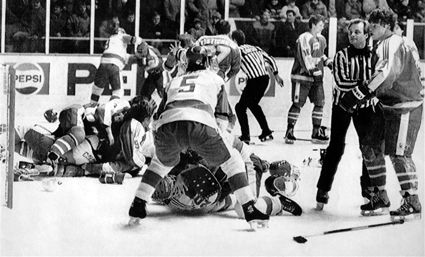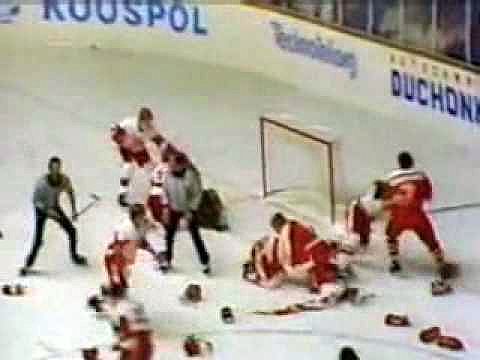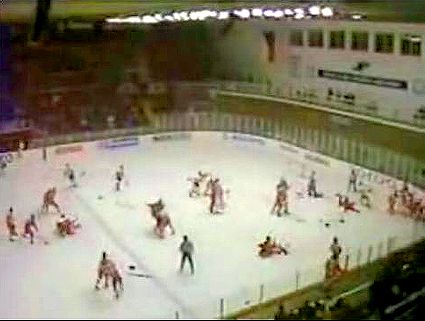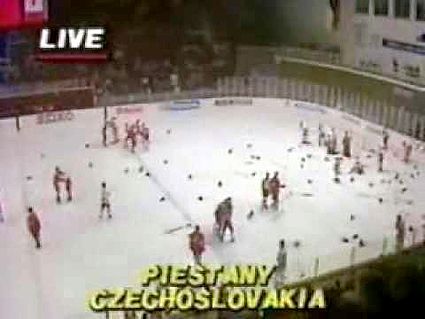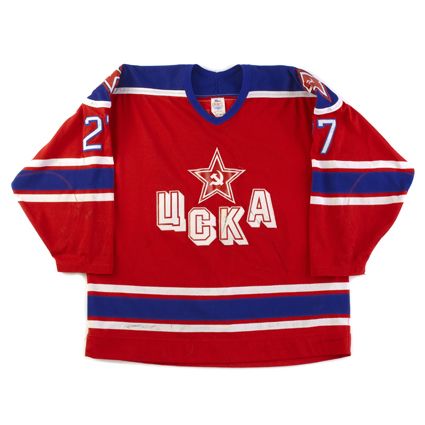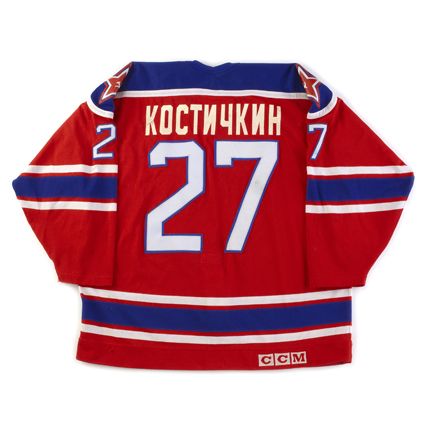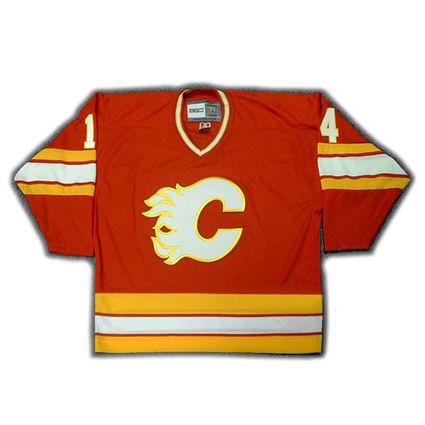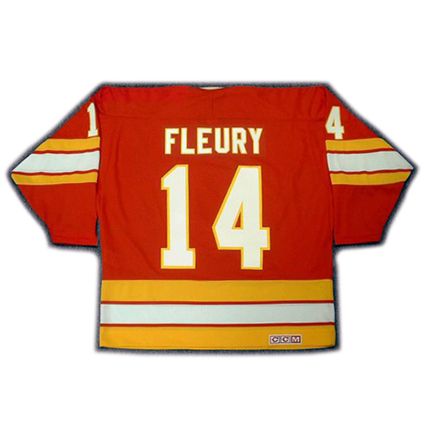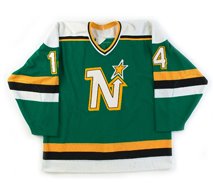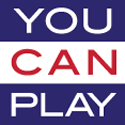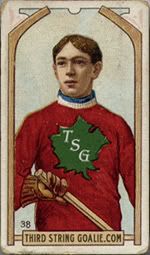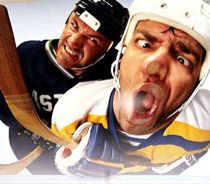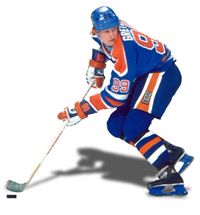In anticipation of tonight's 2015 World Junior Championship Gold Medal Game between host Canada and Russia, the 8th Gold Medal Final between the two nations since the adaptation of the playoff format in 1996, we take a look back at perhaps the most famous, and notorious, moment in World Juniors history, for on this date in 1987, "The Punch-up in Piestany" took place.
The scene was the final game of the 1987 World Junior Tournament in Piestany, Czechoslovakia. At the time the tournament used a simple round-robin format, with the final standings determining the medalists, unlike today's knockout playoff system.
Canada brought a 4-1-1 record into the final game, while their arch-rivals the Soviet Union were out of medal contention at 2-3-1 and could only hope to spoil Canada's chance at the title.
To capture the gold over Finland, the Canadians needed to beat the Soviets by five goals to equal Finland's record of 5-1-1 and surpass them on the goal differential first tie-breaker. Had Canada won by less than five, silver would have been theirs and even a loss would have seen them still take home bronze.
Going into the game, the Canadians were worried about the choice of the inexperienced Hans Ronning as the referee, and sought to have the assignment changed due to an earlier incident in the tournament which involved a pre-game fight between the Canadians and Americans, in which Canadian team captain Steve Chaisson was ejected by Ronning, despite Ronning not even present on the ice at the time. Thanks to his ejection, Chaisson was not only disqualified from the game versus the United States, but their following game against Sweden as well.
The opening faceoff of the game between Canada and the Soviets was met with elbows and a retaliatory cross-check, neither of which were penalized and set the tone for the escalation of hostilities that were to follow.
Five minutes into the game, Theo Fleury scored for Canada and celebrated by sliding across center ice on his knees, using his stick as a machine gun, "firing" at the Soviet bench. The first period would conclude with Canada ahead 3-1, with slashes going uncalled and tempers on both sides getting short.
By the halfway point of the second period each team had another goal, making the score 4-2 in favor of Canada. With two players in the penalty box for each team following a scuffle, Canadian Everett Sanipass and Sergei Shesterikov of the Soviet Union collided after a faceoff, and a fight broke out between the two of them. Things got worse when Pavel Kostichkin hit Fleury with a two-handed slash, which lead to a second fight breaking out. The situation then escalated to the point that all the players on the ice were brawling before the situation spiraled completely out of control when Evgeny Davydov left the Soviet bench to come to the aid of a teammate.
This opened the floodgates, as nearly all the players from both benches spilled onto the ice, and a dozen separate fights broke out. Greg Hagwood's nose was broken by a head-butt and Stephane Roy was beaten by two Soviet players. This was in part due to two Canadians, Jimmy Waite and Pierre Turgeon remaining on the bench, resulting in a numbers advantage for the Soviets on the ice.
Overmatched and unable to control the situation, Ronning and his linesmen then shockingly left the ice and tournament officials famously turned off the arena lights in a desperate attempt to end the brawl!
Eventually the combatants tired themselves out and the fighting ceased, but by that time the IIHF ordered the game suspended and then held an emergency meeting, with the nine delegates voting 8-1 to expel both teams from the tournament, costing Canada a medal of any sort.
With the expulsion of Canada and the Soviet Union, Finland took home the gold, with Czechoslovakia and Sweden being awarded the silver and bronze.
The Canadians were extended an invitation to join the tournament banquet and medal ceremony, but stated they were not interested. Officials responded by ordering Canada out of the arena within a half-hour and they were subsequently escorted out of Czechoslovakia by armed soldiers!
Charges flew in the aftermath, as Alan Eagleson claimed the voting would have been different if the Soviets were in line for a medal as well, while Don Cherry suggested the brawl was a deliberate Soviet conspiracy to get Canada disqualified.
The event spawned our all-time favorite hockey quote ever:
"You don't like to see 20 kids punching 20 other kids.
It's not a disgrace. It's hockey." - Michael Farber
Today's featured jersey is a 1990-91 Soviet Red Army Pavel Kostichkin jersey from his days in the Soviet Hockey League. Kostichkin was eventually drafted in the tenth round by the Winnipeg Jets in 1988, but spent his career in Europe outside of a season with the Moncton Hawks of the AHL. He would eventually play in leagues in Russia, Denmark, Finland and Belarus before retiring in 2005.
With it's bright colors, hammer and sickle logos and name on the back in Cyrillic, it's a prime example of what a hockey jersey should look like and represents the most powerful club in hockey outside of North America.
Bonus Jersey: Todays bonus jersey is a 1996 Canada National Team Theo Fleury jersey as worn during the 1996 World Cup of Hockey. Fleury played internationally for Canada on eight occasions, the first being the notorious 1987 World Juniors. He skated in a second World Juniors in 1988, winning a gold medal. He made his World Championship debut in 1990 and took home a silver on his second try in 1991, the same year he won a gold medal at the 1991 Canada Cup later in the year.
He was a member of the inaugural Canadian World Cup of Hockey roster in 1996 and then made his Olympic debut in 1998, the first year the NHL took a mid-season break to allow it's players the chance to participate. He concluded his international career on a high note, winning a gold medal at the 2002 Olympics in Salt Lake City.
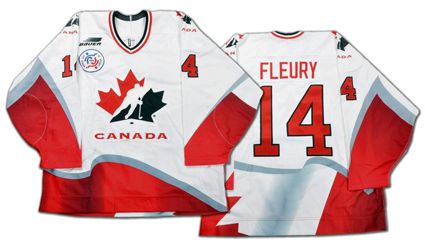
Extra bonus jersey: Today's extra bonus jersey is a 1987 Canada National Team World Juniors jersey of the same style worn by Canada during the "Punch-up in Piestany". The junior teams wore the "three maple leaf and hockey stick" crest during this era rather than the "leaf within a leaf" crest worn by the senior team. There was no player assigned #28 for the 1987 World Juniors, so this jersey was either worn by an unknown player during exhibition games or simply an extra jersey on hand in case of a later roster addition or other need for an emergency spare.
Our video selection today features footage of the brawl between Canada and the Soviet Union, followed by Cherry's postgame comments and then the debate between Cherry and Farber which spawned our favorite quote.



